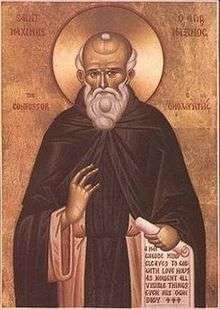October 7 (Eastern Orthodox liturgics)
October 6 - Eastern Orthodox liturgical calendar - October 8
All fixed commemorations below celebrated on October 20 by Orthodox Churches on the Old Calendar.[note 1]
For October 7th, Orthodox Churches on the Old Calendar commemorate the Saints listed on September 24.
Saints
- Hieromartyrs Julian the Presbyter, and Caesarius the Deacon, at Terracina (1st century or 268)[1][2][3][4][5]
- Hieromartyr Eusebius the Priest and martyr Felix, at Terracina (1st century or 268)[1][3][4][6]
- Saint Leontius the Governor, at Terracina (1st century or 268)[1][3][4][6]
- Virgin-martyr Pelagia of Tarsus in Asia Minor (287)[1][7][8][9] (see also: October 8 - Greek)
- Martyrs Sergius and Bacchus, in Syria (290-303)[1][3][10][11][12][note 2][note 3]
- Hieromartyr Polychronius, Priest, of Gamphanitus (4th century)[1][3][9][14][15][note 4][note 5]
- Ten companions with Hieromartyr Polychronius (4th century):[4][16]
- Saints Parmenias, Polyteleios, Elymos, Mocius, Chrysotelis, Maximus, Luke, Obadiah, Semnios and Olympiada.
Pre-Schism Western saints
- Saint Justina of Padua, a virgin-martyr in Padua in Italy under Diocletian (c. 300)[17][note 6][note 7]
- Martyrs Marcellus and Apuleius, in Capua in Italy.[17][note 8][note 9]
- Saint Mark, Pope of Rome (336)[1][17][note 10]
- Saint Canog (Cynog), martyred by barbarians in Merthyr Cynog (c.492)[17][note 11]
- Saint Dubthach the First, Archbishop of Armagh in Ireland from 497 (513)[1][7][17]
- Saint Palladius of Saintes, Bishop of Saintes in France (c.590)[17][20]
- Saint Augustus, Abbot of Bourges in France and a friend of St Germanus of Paris (6th century)[17][note 12][note 13][note 14]
- Saint Helanus, priest, in the diocese of Rheims in France (6th century)[13][17][note 15]
- Martyr Osyth (Osith), Princess of Chich, England (c. 700)[1][7][17][21][22][note 16]
- Saint Adalgis, Bishop of Novara in Italy (c.830-c.850)[17][note 17]
Post-Schism Orthodox saints
- Venerable John the Hermit[3] and 98 Venerable Fathers of Crete.[1][4][7][23][24][25][note 18]
- Venerable Sergius the Obedient of the Kiev Caves Monastery (13th century)[1][3][4][7][9][26][27]
- Venerable Sergius of Nurma in Vologda, Abbot (1412), disciple of St. Sergius of Radonezh.[1][7][9][28][note 19]
- Venerable Joseph, Elder and Wonderworker, of Khevi, Georgia (1763)[1][7][29]
- Saint Jonah of Manchuria, Bishop of Hankou, Manchuria, Wonderworker (1925)[1][7]
Other commemorations
- Uncovering (1514) of the relics of St. Martinian of Byelozersk, Abbot of Kirillo-Belozersky Monastery (White Lake) (1483)[1][4][7][9][30][note 22]
- Icon of the Mother of God "Tenderness" of the Pskov Caves (1524)[4][7][9][31][note 23]
- Synaxis of Panagia Nafpaktiotissa (Virgin of Nafpaktos) (1571)[32][33][note 24][note 25]
- Uncovering of the relics (1906) of St. John Triantaphyllides, the New Chrysostom and Merciful, of Chaldia in Asia Minor (1903)[34][35]
Icon gallery
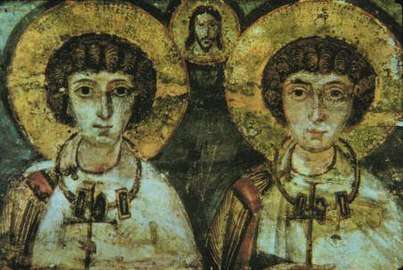 Martyrs Sergius and Bacchus.
Martyrs Sergius and Bacchus..jpg) Martyrs Sergius and Bacchus.
Martyrs Sergius and Bacchus..jpg) Virgin-martyr Pelagia of Tarsus.
Virgin-martyr Pelagia of Tarsus. Hieromartyr Polychronius.
Hieromartyr Polychronius.- Vernable John the Hermit and 98 Venerable Fathers of Crete.
.jpg) St. Jonah of Manchuria, Bishop of Hankou.
St. Jonah of Manchuria, Bishop of Hankou.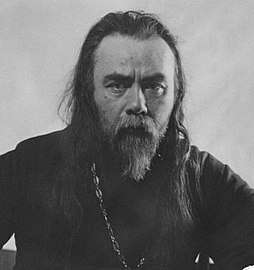 New Hieromartyr Valentine Sventsitsky.
New Hieromartyr Valentine Sventsitsky.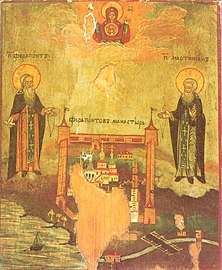 Sts. Ferapont and Martinian, of Kirillo-Belozersky Monastery.
Sts. Ferapont and Martinian, of Kirillo-Belozersky Monastery.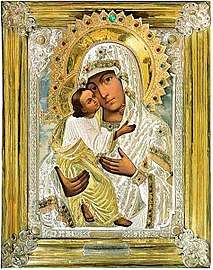 Icon of the Mother of God "Tenderness" of the Pskov Caves
Icon of the Mother of God "Tenderness" of the Pskov Caves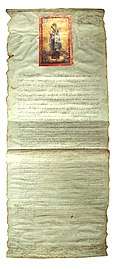 An 11th-century parchment showing the "Virgin of Nafpaktos".
An 11th-century parchment showing the "Virgin of Nafpaktos".- Sts.Sergius and Bacchus and Justina of Padua
(By Damaskinos, commemorating the naval victory at Lepanto)
Notes
- The notation Old Style or (OS) is sometimes used to indicate a date in the Julian Calendar (which is used by churches on the "Old Calendar").
The notation New Style or (NS), indicates a date in the Revised Julian calendar (which is used by churches on the "New Calendar"). - Name days celebrated today include:
- Sergios, Sergio, Serge (Σέργιος).
- "In the province of the Euphrates, the holy martyrs Sergius and Bacchus, noble Romans, in the time of the emperor Maximian. Bacchus, being scourged with rough whips until his body was completely mangled, breathed his last in the confession of Christ. Sergius had his feet forced into shoes full of sharp-pointed nails, and, remaining unshaken in the faith, he was sentenced to undergo capital punishment. The place where he reposes is called after him Sergiopolis, and, on account of the signal miracles wrought in it, is honored by a great concourse of Christians."[13]
- Name days celebrated today include:
- Polychronis (Πολυχρόνιος);
- Polychronia (Πολυχρονία).
- See: (in Greek) Άγιος Πολυχρόνιος. Βικιπαίδεια. (Greek Wikipedia).
- "At Padua, St. Justina, virgin and martyr, who was baptized by the blessed Prosdocimus, disciple of St. Peter. As she remained firm in the faith of Christ, she was put to the sword by order of the governor Maximus, and thus went to God."[13]
- "Not found in any ancient Martyrology. The Acts are a late mediaeval forgery; also the forged Acts of S. Prosdochimus, both compositions of the I2th cent."[18]
- "At Rome, the holy martyrs Marcellus and Apuleius, who at first followed Simon Magus, but seeing the wonders which the Lord performed by the Apostle Peter, abandoned Simon, and embraced the apostolical doctrine. After the death of the Apostles, under the ex-consul Aurelian, they won the crown of martyrdom, and were buried near the city."[13]
- "Marcellus and Apuleius seem to be the same as Nicetas and Aquila, mentioned in the Clementines as disciples of Simon Magus; the Martyrologies speak of them as following Simon till converted by S. Peter. On reference to the Clementine Recognitions, that most extraordinary philosophical religious romance of the 2nd century, we find that their names in Greek were Nicetas and Aquila. The inventor of the Acts of SS. Nereus and Achilles adopted their story into his composition, and crowned them with martyrdom. They are purely apocryphal personages."[19]
- "At Rome, on the Ardeatine road, the demise of St. Mark, pope and confessor."[13]
- Several churches in Wales were dedicated to him.
- "At Bourges, St. Augustus, priest and confessor."[13]
- He is notable for discovering the relics of St Ursinus, Apostle of that region.
- See: (in Italian) Augusto di San Sinforiano. Wikipedia. (Italian Wikipedia).
- Born in Ireland, he went to France with nine other members of his family, six brothers and three sisters, and settled near Rheims. He became a priest and ministered there.
- Osyth was a princess of the Hwiccas in the west of England. She married Sighere, King of the East Saxons. Their son, the future St Offa, became King in 683, later abdicating. Osyth founded a convent, now St Osyth, on a creek of the River Colne in Essex.
- He is buried in the Church of San Gaudenzio.
- They are referenced only by St. Nicodemus the Hagiorite. A service to them was issued in Heraklion in 1879, which says that they all reposed peacefully around the same time.
- See: (in Russian) Сергий Нуромский. Википедии. (Russian Wikipedia).
- See: (in Russian) Свенцицкий, Валентин Павлович. Википедии. (Russian Wikipedia).
- See: (in Russian) Казанский, Николай Фёдорович. Википедии. (Russian Wikipedia).
- See: (in Russian) Мартиниан Белозерский. Википедии. (Russian Wikipedia).
- See: (in Russian) Псково-Печерская икона «Умиление». Википедии. (Russian Wikipedia).
- On October 7th (or on the first Sunday after October 7th - between October 7–13), Nafpaktos celebrates the Panagia of Nafpaktos in memory of the Battle of Lepanto which took place on October 7, 1571, where the Christian European fleet decisively defeated the fleet of the Ottoman Empire.
- See: (in Greek) Παναγία Ναυπακτιώτισσα. Βικιπαίδεια. (Greek Wikipedia).
- In the West, she is known as the "Madonna di Lepanto" or "Santa Maria del Rozario':
- "THE feast of the Most Holy Rosary of the Blessed Virgin Mary, and the commemoration of Our Lady of Victory, which the sovereign Pontiff, blessed Pius V., on account of the great naval victory gained by the Christians on this day, ordered to be kept annually."[13]
gollark: Idea: raise children on untyped lambda calculus.
gollark: Cool, it has MANY pronouns.
gollark: > Māori distinguishes between long and short vowels; modern written texts usually mark the long vowels with a macron.IT SPREADS.
gollark: Statistically, you OBVIOUSLY can.
gollark: > The 2013 New Zealand census reported that about 149,000 people, or 3.7% of the New Zealand population, could hold a conversation in Māori about everyday things.[2][6] As of 2015, 55% of Māori adults reported some knowledge of the language; of these, 64% use Māori at home and around 50,000 people can speak the language "very well" or "well".[1]
References
- October 7/20. Orthodox Calendar (PRAVOSLAVIE.RU).
- Great Synaxaristes: (in Greek) Οἱ Ἅγιοι Ἰουλιανὸς ὁ πρεσβύτερος καὶ Καισάριος ὁ διάκονος. 7 ΟΚΤΩΒΡΙΟΥ. ΜΕΓΑΣ ΣΥΝΑΞΑΡΙΣΤΗΣ.
- (in Greek) Συναξαριστής. 7 Οκτωβρίου. ECCLESIA.GR. (H ΕΚΚΛΗΣΙΑ ΤΗΣ ΕΛΛΑΔΟΣ).
- (in Greek) 07/10/2017. Ορθόδοξος Συναξαριστής.
- Martyr Julian the Presbyter at Terracina. OCA - Lives of the Saints.
- Great Synaxaristes: (in Greek) Οἱ Ἅγιοι Λεόντιος ὁ Ὑπατικὸς, Εὐσέβιος ὁ Πρεσβύτερος καὶ Φήλιξ. 7 ΟΚΤΩΒΡΙΟΥ. ΜΕΓΑΣ ΣΥΝΑΞΑΡΙΣΤΗΣ.
- October 20 / October 7. HOLY TRINITY RUSSIAN ORTHODOX CHURCH (A parish of the Patriarchate of Moscow).
- Martyr Pelagia of Tarsus. OCA - Lives of the Saints.
- (in Russian) 7 октября по старому стилю / 20 октября по новому стилю. Русская Православная Церковь - Православный церковный календарь на 2016 год.
- Great Synaxaristes: (in Greek) Οἱ Ἅγιοι Σέργιος καὶ Βάκχος. 7 ΟΚΤΩΒΡΙΟΥ. ΜΕΓΑΣ ΣΥΝΑΞΑΡΙΣΤΗΣ.
- Martyr Sergius in Syria. OCA - Lives of the Saints.
- Rev. Sabine Baring-Gould (M.A.). "SS. SERGIUS AND BACCHUS, MM. (ABOUT A.D. 301.)" In: The Lives of the Saints. Volume the Eleventh: October – Part I. London: John C. Nimmo, 1898. p. 155.
- The Roman Martyrology. Transl. by the Archbishop of Baltimore. Last Edition, According to the Copy Printed at Rome in 1914. Revised Edition, with the Imprimatur of His Eminence Cardinal Gibbons. Baltimore: John Murphy Company, 1916. pp. 309–310.
- Great Synaxaristes: (in Greek) Ὁ Ἅγιος Πολυχρόνιος ὁ Ἱερομάρτυρας. 7 ΟΚΤΩΒΡΙΟΥ. ΜΕΓΑΣ ΣΥΝΑΞΑΡΙΣΤΗΣ.
- Martyr Polychronius the Presbyter. OCA - Lives of the Saints.
- Great Synaxaristes: (in Greek) Οἱ Ἅγιοι Παρμενίας, Πολυτέλειος, Ἐλυμᾶς, Μώκιος, Χρυσοτέλης, Μάξιμος, Λουκᾶς, Ἀβδίας, Σέμνιος καὶ Ὀλυμπιάδα. 7 ΟΚΤΩΒΡΙΟΥ. ΜΕΓΑΣ ΣΥΝΑΞΑΡΙΣΤΗΣ.
- October 7. Latin Saints of the Orthodox Patriarchate of Rome.
- Rev. Sabine Baring-Gould (M.A.). "S. JUSTINA, V.M. (date uncertain)" In: The Lives of the Saints. Volume the Eleventh: October – Part I. London: John C. Nimmo, 1898. pp. 152-154.
- Rev. Sabine Baring-Gould (M.A.). "SS. MARCELLUS AND APULEIUS, MM. (1ST CENTURY)" In: The Lives of the Saints. Volume the Eleventh: October – Part I. London: John C. Nimmo, 1898. p. 154.
- Rev. Sabine Baring-Gould (M.A.). "S. PALLADIUS, B. OF SAINTES. (ABOUT A.D. 600.)" In: The Lives of the Saints. Volume the Eleventh: October – Part I. London: John C. Nimmo, 1898. pp. 156-160.
- Rev. Richard Stanton. A Menology of England and Wales, or, Brief Memorials of the Ancient British and English Saints Arranged According to the Calendar, Together with the Martyrs of the 16th and 17th Centuries. London: Burns & Oates, 1892. pp. 477-478.
- Rev. Sabine Baring-Gould (M.A.). "S. OSYTH, V.M. (END OF 7TH CENTURY)" In: The Lives of the Saints. Volume the Eleventh: October – Part I. London: John C. Nimmo, 1898. pp. 161-163.
- Great Synaxaristes: (in Greek) Ὁ Ὅσιος Ἰωάννης καὶ οἱ σὺν αὐτῷ Ὅσιοι 99 Πατέρες ποὺ ἀσκήτευσαν στὴν Κρήτη. 7 ΟΚΤΩΒΡΙΟΥ. ΜΕΓΑΣ ΣΥΝΑΞΑΡΙΣΤΗΣ.
- 99 Martyred Fathers of Crete. OCA - Lives of the Saints.
- St. John the Hermit and the 98 Fathers of Crete. Mystagogy. Thuirsday, October 7, 2010. Retrieved: 17 February 2017.
- Venerable Sergius the Obedient of the Kiev Near Caves. OCA - Lives of the Saints.
- Great Synaxaristes: (in Greek) Ὁ Ὅσιος Σέργιος ὁ ἐν τῷ Σπηλαίῳ (Ρῶσος). 7 ΟΚΤΩΒΡΙΟΥ. ΜΕΓΑΣ ΣΥΝΑΞΑΡΙΣΤΗΣ.
- Venerable Sergius the Abbot of Nurma and Disciple of the Venerable Sergius of Radonezh, Vologda. OCA - Lives of the Saints.
- Venerable Joseph the Elder and Wonderworker of Khevi, Georgia. OCA - Lives of the Saints.
- Uncovering of the relics of the Venerable Martinian the Abbot of Belozersk. OCA - Lives of the Saints.
- Icon of the Mother of God “Tenderness” of the Pskov Caves. OCA - Lives of the Saints.
- Great Synaxaristes: (in Greek) Μνήμη Παναγίας Ναυπακτιώτισσας. 7 ΟΚΤΩΒΡΙΟΥ. ΜΕΓΑΣ ΣΥΝΑΞΑΡΙΣΤΗΣ.
- (in Greek) Σύναξη της Υπεραγίας Θεοτόκου της «Ναυπακτιώτισσας». Ορθόδοξος Συναξαριστής.
- (in Greek) Ανακομιδή των Ιερών λειψάνων του Οσίου Ιωάννου του πρεσβυτέρου, του νέου χρυσοστόμου και ελεήμονος, εκ Χαλδίας Μικράς Ασίας. Ορθόδοξος Συναξαριστής.
- Saint John Triantaphyllides, the New Chrysostom and Merciful (+1903). Mystagogy Resource Center. June 13, 2016.
Sources
- October 7/20. Orthodox Calendar (PRAVOSLAVIE.RU).
- October 20 / October 7. HOLY TRINITY RUSSIAN ORTHODOX CHURCH (A parish of the Patriarchate of Moscow).
- October 7. OCA - The Lives of the Saints.
- The Autonomous Orthodox Metropolia of Western Europe and the Americas (ROCOR). St. Hilarion Calendar of Saints for the year of our Lord 2004. St. Hilarion Press (Austin, TX). pp. 74–75.
- The Seventh Day of the Month of October. Orthodoxy in China.
- October 7. Latin Saints of the Orthodox Patriarchate of Rome.
- The Roman Martyrology. Transl. by the Archbishop of Baltimore. Last Edition, According to the Copy Printed at Rome in 1914. Revised Edition, with the Imprimatur of His Eminence Cardinal Gibbons. Baltimore: John Murphy Company, 1916. pp. 309–310.
- Rev. Richard Stanton. A Menology of England and Wales, or, Brief Memorials of the Ancient British and English Saints Arranged According to the Calendar, Together with the Martyrs of the 16th and 17th Centuries. London: Burns & Oates, 1892. pp. 477–478.
Greek Sources
- Great Synaxaristes: (in Greek) 7 ΟΚΤΩΒΡΙΟΥ. ΜΕΓΑΣ ΣΥΝΑΞΑΡΙΣΤΗΣ.
- (in Greek) Συναξαριστής. 7 Οκτωβρίου. ECCLESIA.GR. (H ΕΚΚΛΗΣΙΑ ΤΗΣ ΕΛΛΑΔΟΣ).
- (in Greek) 07/10/2017. Ορθόδοξος Συναξαριστής.
Russian Sources
- (in Russian) 20 октября (7 октября). Православная Энциклопедия под редакцией Патриарха Московского и всея Руси Кирилла (электронная версия). (Orthodox Encyclopedia - Pravenc.ru).
- (in Russian) 7 октября по старому стилю / 20 октября по новому стилю. Русская Православная Церковь - Православный церковный календарь на 2016 год.
This article is issued from Wikipedia. The text is licensed under Creative Commons - Attribution - Sharealike. Additional terms may apply for the media files.

